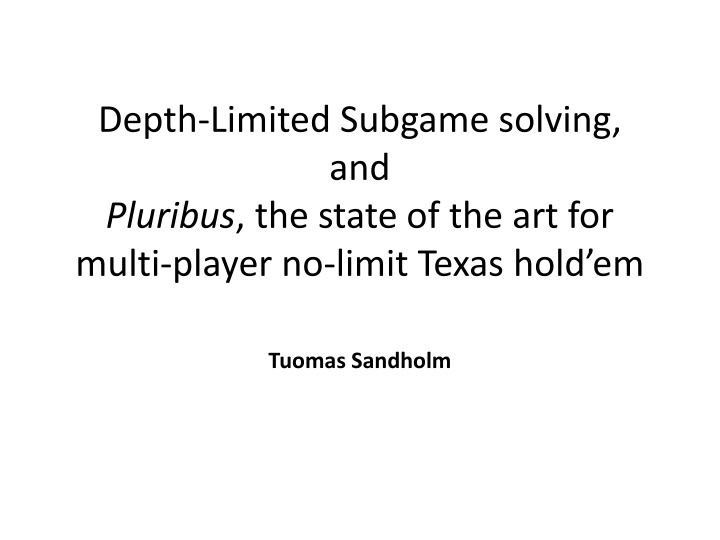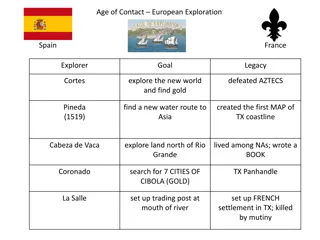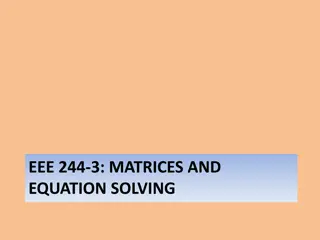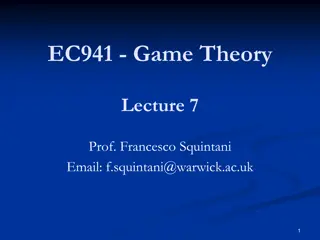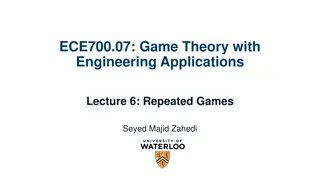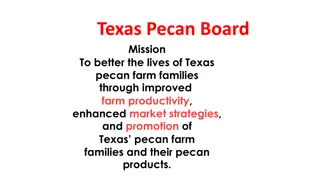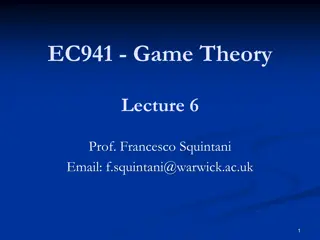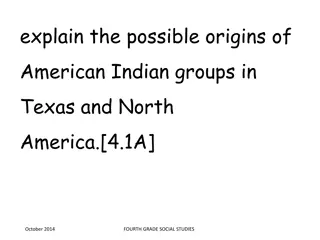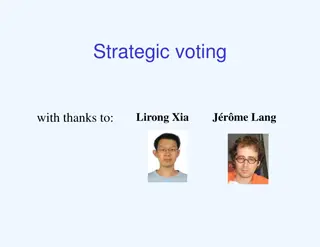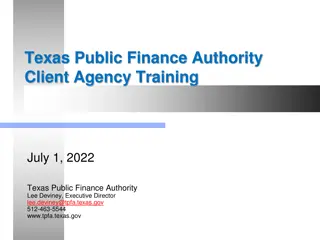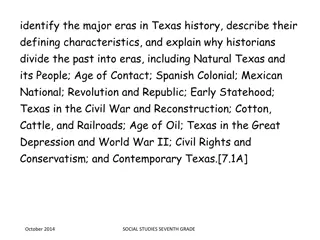Deep-Limited Subgame Solving and Pluribus: The Future of Texas Hold'em
Cutting-edge research by Tuomas Sandholm explores depth-limited subgame solving and its implications for multiplayer no-limit Texas hold'em. Advances in perfect vs. imperfect information games along with strategies like Libratus and DeepStack are transforming game theory.
Download Presentation

Please find below an Image/Link to download the presentation.
The content on the website is provided AS IS for your information and personal use only. It may not be sold, licensed, or shared on other websites without obtaining consent from the author.If you encounter any issues during the download, it is possible that the publisher has removed the file from their server.
You are allowed to download the files provided on this website for personal or commercial use, subject to the condition that they are used lawfully. All files are the property of their respective owners.
The content on the website is provided AS IS for your information and personal use only. It may not be sold, licensed, or shared on other websites without obtaining consent from the author.
E N D
Presentation Transcript
Depth-Limited Subgame solving, and Pluribus, the state of the art for multi-player no-limit Texas hold em Tuomas Sandholm
DEPTH-LIMITED SEARCH FOR IMPERFECT-INFORMATION GAMES [BROWN, SANDHOLM & AMOS, NEURIPS-18]
Perfect-information games and single-agent search Remaining game is too large
Perfect-information games and single-agent search Value substituted at leaf node is estimate of both players playing perfectly thereafter If estimate is perfect, limited-lookahead search finds optimal policy (equilibrium) But state values are not well defined in imperfect-information games!
Depth-limited solving [Brown, Sandholm & Amos NeurIPS-18e] Rock-Paper-Scissors+ Depth-Limited Rock-Paper-Scissors+ ?? ?? Paper Paper ? = 0.4 ? = 0.4 ? = 0.2 0 0 0 ?? ?? ?? ? = 0.4 ? = 0.4 ? = 0.2 ? = 0.4 ? = 0.2 ? = 0.2 Paper Paper Paper ? = 0.4 ? = 0.4 ? = 0.4 1 0 0 -1 2 -2 -2 2 0
Depth-limited solving [Brown, Sandholm & Amos NeurIPS-18e] Rock-Paper-Scissors+ Depth-Limited Rock-Paper-Scissors+ ?? ?? Paper Paper ? = 0.8 ? = 0.8 ? = 0.1 ? = 0.1 ? = 0.1 ? = 0.1 0 0 0 ?? ?? ?? Paper Paper Paper 1 0 0 -1 2 -2 -2 2 0
Depth-limited solving [Brown, Sandholm & Amos NeurIPS-18e] Rock-Paper-Scissors+ Depth-Limited Rock-Paper-Scissors+ ?? ?? Paper Paper ? = 0.8 ? = 0.1 ? = 0.1 0 0 0 ?? ?? ?? 0 -1 2 Paper Paper Paper 1 0 0 -1 2 -2 -2 2 0 How to tackle this issue? Libratus: When solving a subgame, solves it to the end of the game DeepStack: Solves depth-limited subgames, but is very expensive and relies on certain structure Our new approach: Solves depth-limited subgames, and is very cheap and general
Depth-limited solving [Brown, Sandholm & Amos NeurIPS-18e] Rock-Paper-Scissors+ Depth-Limited Rock-Paper-Scissors+ ?? ?? Paper Paper ?? ?? ?? ?? ?? ?? Paper Paper Paper ?2 ?2 ?2 1 1 1 1 0 0 0 0 0 -1 2 -2 -2 2 0 At leaf nodes, allow other player(s) one final action choosing among multiple policies for the remaining game Step 1: Solve subgame with current set of ?2 leaf-node policies Step 2: Calculate a ?2 best response Step 3: Add ?2 best response to set of leaf-node policies Repeat
Depth-limited solving [Brown, Sandholm & Amos NeurIPS-18e] Rock-Paper-Scissors+ Depth-Limited Rock-Paper-Scissors+ ?? ?? Paper Paper ? =? ? =? ? =? ? ? ? ?? ?? ?? ?? ?? ?? Paper Paper Paper ?2 ?2 ?2 1 1 1 1 0 0 0 0 0 -1 2 -2 -2 2 0 At leaf nodes, allow other player(s) one final action choosing among multiple policies for the remaining game Step 1: Solve subgame with current set of ?? leaf-node policies Step 2: Calculate a ?2 best response Step 3: Add ?2 best response to set of leaf-node policies Repeat
Depth-limited solving [Brown, Sandholm & Amos NeurIPS-18e] Rock-Paper-Scissors+ Depth-Limited Rock-Paper-Scissors+ ?? ?? Paper Paper ? =? ? =? ? =? ? =? ? =? ? =? ? ? ? ? ? ? ?? ?? ?? ?? ?? ?? Paper Paper Paper ?2 ?2 ?2 1 1 1 1 0 0 0 0 0 -1 2 -2 -2 2 0 At leaf nodes, allow other player(s) one final action choosing among multiple policies for the remaining game Step 1: Solve subgame with current set of ?2 leaf-node policies Step 2: Calculate a ?? best response Step 3: Add ?2 best response to set of leaf-node policies Repeat
Depth-limited solving [Brown, Sandholm & Amos NeurIPS-18e] Rock-Paper-Scissors+ Depth-Limited Rock-Paper-Scissors+ ?? ?? Paper Paper ? =? ? =? ? =? ? =? ? =? ? =? ? ? ? ? ? ? ?? ?? ?? ?? ?? ?? Paper Paper Paper ?2 ?2 ?2 1 1 1 1 0 0 0 0 0 -1 2 -2 -2 2 0 At leaf nodes, allow other player(s) one final action choosing among multiple policies for the remaining game Step 1: Solve subgame with current set of ?2 leaf-node policies Step 2: Calculate a ?? best response Step 3: Add ?2 best response to set of leaf-node policies Repeat
Depth-limited solving [Brown, Sandholm & Amos NeurIPS-18e] Rock-Paper-Scissors+ Depth-Limited Rock-Paper-Scissors+ ?? ?? Paper Paper ?? ?? ?? ?? ?? ?? Paper Paper Paper ?2 ?2 ?2 1 1 1 1 0 -2 1 0 0 0 0 0 -1 2 -2 -2 2 0 At leaf nodes, allow other player(s) one final action choosing among multiple policies for the remaining game Step 1: Solve subgame with current set of ?2 leaf-node policies Step 2: Calculate a ?2 best response Step 3: Add ?? best response to set of leaf-node policies Repeat
Depth-limited solving [Brown, Sandholm & Amos NeurIPS-18e] Rock-Paper-Scissors+ Depth-Limited Rock-Paper-Scissors+ ?? ?? Paper Paper ? = ?.? ? = ?.? ? = ?.? ?? ?? ?? ?? ?? ?? Paper Paper Paper ?2 ?2 ?2 1 1 1 1 0 -2 1 0 0 0 0 0 -1 2 -2 -2 2 0 At leaf nodes, allow other player(s) one final action choosing among multiple policies for the remaining game Step 1: Solve subgame with current set of ?? leaf-node policies Step 2: Calculate a ?2 best response Step 3: Add ?2 best response to set of leaf-node policies Repeat There are also other ways to generate continuation policies for the opponent. Theorem. Converges to Nash equilibrium. In practice, reaches very low exploitability in a small number of iterations.
Safe depth-limited solving starting later than the root [Brown, Sandholm & Amos NeurIPS-18e] In imperfect-information games, subgames are not independent However, techniques from Libratus s endgame solving can be applied, but now the endgames are midgames that end in continuation strategy choices Have a blueprint strategy for the whole game E.g., via abstraction+equilibrium computation, Deep CFR [Brown, Lerer, Gross & Sandholm, ICML-19c], or manual When determining our strategy for an endgame, give opponent the choice of model: blueprint or endgame model [Burch et al. AAAI-14; Jackson AAAI-14; Moravcik et al. AAAI-16; Brown & Sandholm NIPS-17; Moravcik et al. Science 2017; Brown & Sandholm Science 2018] Want to solve for our endgame strategy such that opponent isn t better off choosing endgame model for any private type she may have => Theorem: safe Allow opponent to get back in the endgame the gifts she has given so far => Theorem: safe [Brown & Sandholm NIPS-17 Best Paper; Science 2018] Can apply this recursively Can include the action that the opponent made Can use finer abstraction when endgame starts closer to end of the game Theorem: Safe [Brown & Sandholm NIPS-17 Best Paper; Science 2018]
Head-to-head performance in 2-player no-limit Texas hold em [Brown, Sandholm & Amos NeurIPS-18e] Baby Tartanian8 [2016 champion] 2 million core hours 18 TB of memory Slumbot [2018 champion] 250,000 core hours 2 TB of memory Modicum 700 core hours 16 GB of memory Plays in real time with a 4-core CPU in 20 seconds per hand Baby Tartanian8 Slumbot ?? ?? ?? ? Modicum (no real-time reasoning) ?? ? ? ?? Modicum (just one continuation strategy) ? ? ?? ? Modicum (just a few continuation strategies) Unit: milli-big-blinds / game
Key takeaways from this segment Planning is important in imperfect-information games, but different In real-time planning, you must consider how the opponent can adapt to changes in your strategy Except in perfect-information games and single-agent setting States don t have well-defined values in imperfect-info games Our depth-limited solving algorithm: Is sound Enabled 2nd-best AI for heads-up no-limit Texas hold em poker to be developed on a 4-core CPU with 16 GB of RAM
Multi-player games All prior superhuman AI game-playing milestones have been in 2-player games: Checkers: Chinook 1994 Othello: Logistello 1997 Chess: Deep Blue 1997 2-player limit Texas hold em: Polaris 2008 Go: AlphaGo 2016 2-player no-limit Texas hold em: Libratus 2017 Starcraft II: AlphaStar 2019 and DOTA 2: OpenAI Five 2019 (if they are superhuman) Our research led to techniques that enabled us to develop a superhuman AI for multi-player no-limit Texas hold em
Multi-player poker Recognized AI, game theory, and OR milestone that has been open for decades Most popular variant in the world: 6-player no-limit Texas hold em Very recently we developed a superhuman AI, Pluribus, for this game [Brown & Sandholm, Science 2019] Science Breakthrough of the Year runner-up, 2019
2-player 0-sum vs. multi-player games All prior superhuman AI game milestones have been in 2-player 0-sum games Multi-player games have additional issues (even in normal form): Playing a Nash equilibrium is not safe Finding even an approximate Nash equilibrium is hard In theory [Daskalakis et al. 2009; Chen et al. 2009; Rubinstein 2018] In practice, fastest complete algorithm only scales to 3-5 players and 3-5 strategies per player [Berg & Sandholm AAAI-17] Pluribus finds superhuman strategies with a novel set of algorithms No guarantee that the solution is a Nash equilibrium (beyond 2-player 0-sum games)
How does Pluribus work? Developed and runs on a single server, no GPUs Doesn t use any data Doesn t adapt to the opponent Offline blueprint computation and real-time depth-limited search
Pluribus Rules of the game Abstraction generation Information abstraction algorithm [Brown, Ganzfried & Sandholm, AAMAS-15] Action abstraction Coarse abstraction of the game Finer abstraction of the game Computing strategy for depth-limited subgame Blueprint computation (offline) Blueprint strategy profile Action
Pluribus Rules of the game Abstraction generation Information abstraction algorithm [Brown, Ganzfried & Sandholm, AAMAS-15] Action abstraction Coarse abstraction of the game Finer abstraction of the game Computing strategy for depth-limited subgame Blueprint computation (offline) Blueprint strategy profile Action
Pluribuss new form of depth-limited search for imperfect-information games All players (not just opponents) pick from k continuation strategies at leaves Search starts before current situation (beginning of current betting round) Mitigates exploitability of unsafe search while keeping its advantages Our player s strategy is kept fixed for the moves already taken As in Libratus, opponents actual actions are added to subgame model before the subgame is solved => no need to reverse map actions
Pluribus Rules of the game Abstraction generation Information abstraction algorithm [Brown, Ganzfried & Sandholm, AAMAS-15] Action abstraction Coarse abstraction of the game Finer abstraction of the game Computing strategy for depth-limited subgame Blueprint computation (offline) Blueprint strategy profile Action
Pluribus Rules of the game Abstraction generation Information abstraction algorithm [Brown, Ganzfried & Sandholm, AAMAS-15] Action abstraction Coarse abstraction of the game Finer abstraction of the game Computing strategy for depth-limited subgame Blueprint computation (offline) Blueprint strategy profile Action
Pluribuss new equilibrium-finding algorithm Used for blueprint computation and for solving depth- limited subgames Significant improvement over MCCFR [Lanctot et al., NeurIPS-09] Linear CFR [Brown & Sandholm AAAI-19 Distinguished Paper Honorable Mention] Pluribus uses linear weighting for both regrets and for averaging the strategies => Linear MCCFR New form of dynamic pruning in early part of the run Not in last two steps of the game Saving memory: sequences allocated in RAM only if encountered
At play time, Pluribus: Runs on a regular computer using 2 CPUs Less than 128 GB RAM No GPUs Plays twice as fast as human pros (20 sec / hand)
Performance against top human pros AIVAT [Burch et al. AAAI-18] was used in the evaluation for variance reduction Experiment 1: 1 human pro, 5 copies of Pluribus Independent copies of Pluribus; didn t know even seat of others Each of Chris Ferguson and Darren Elias played 5,000 hands (also, monetary incentive to play as well as they can) Pluribus beat each opponent with statistical significance In a later identical experiment, Pluribus also beat Linus Loeliger Experiment 2: 5 human pros, 1 Pluribus 10,000 hands For each 6-player session, 5 humans were selected based on availability from 13 human pros Each has won over $1M playing poker, many have won over $10M Linus Loeliger, Jimmy Chou, Seth Davies, Michael Gagliano, Anthony Gregg, Dong Kim, Jason Les, Daniel McAulay, Nick Petrangelo, Sean Ruane, Trevor Savage, Jake Toole $50,000 divided among human pros to incentivize them to play as well as they can Pluribus won with statistical significance (p=0.028)
Improvement of Pluribus with training time 64-core server, 512 GB RAM, no GPUs ~$150 at cloud prices
